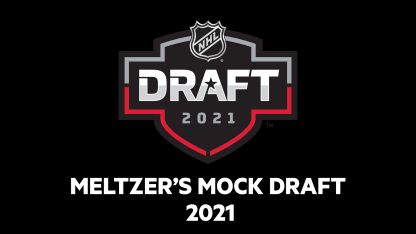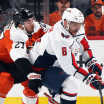The 2021 NHL Entry Draft is not considered to be as deep, either in terms of potential franchise-player talent at the top end or in terms of players with currently bankable NHL top-six forward or top-three defenseman upsides within the next year or two.
Meltzer's 2021 Mock Entry Draft

However, there are bound to be long-term pleasant surprises to emerge from the pandemic-affected season. There's no shortage of potential middle-six forwards or top-four defensemen; some of whom could progress to the upper end those projections (or even exceed them) in their post-Draft development. There are also two highly regarded goaltending prospects who are expected to be selected in the first round this year; possibly with both going within the first 15 picks.
There also could be a higher-than-average number of latter-round picks whose careers surpass those of many players chosen significantly earlier. Every team in the league is in the same boat in terms of the added guesswork that's gone in to the already imperfect science of scouting 17-year-old and 18-year-old players to project their long-term impacts.
Partially owing to the Draft's overall depth and partially to the cancellations of seasons worldwide in the latter part of the 2019-20 season and the widespread delays (or, in the case of the Ontario Hockey League the complete cancelation) of the 2020-21 season, observers will notice that there a higher-than-normal number of late-birthday players (post-September 15) born in 2002 within the first round projections.
The Philadelphia Flyers currently own the 13th overall pick of the first round. Subsequently they hold one pick apiece in Rounds Two through Seven. It is possible that the Flyers could trade some of their picks, possibly even the first-rounder, in trades geared toward bolstering their current NHL roster. However, there is at least an equal possibility that the team will hold onto its picks and any maneuvering that's done will involve only swapping picks to either move up or acquire an additional pick in 2021 or 2022.
As usual, the following Mock Draft is a guessing game exercise -- not a prediction -- based on a best-available-prospect model. In most cases, organizational needs by position were not considered. The exception was with the goalies, where organizational needs were a potential tipping point among otherwise closely spaced prospects.
1. Buffalo Sabres -- Owen Power, D (University of Michigan, NCAA)
A late birthday player born on Nov. 22, 2002, Power may not quite be projected as a franchise player who becomes a prolific NHL point-getter but his combination of size, mobility and two-way upside make him the consensus first overall pick this year. It would be a surprise if any other player gets selected ahead of him.
Power is one of three University of Michigan players who are projected first-round selections this year. Beyond Power, the actual selection order come Draft Day could differ significantly on a numerical basis but the Top 10 overall appears to be fairly well defined.
2. Seattle Kraken -- William Eklund, LW/C (Djurgården, SEL)
The only traits that the 2002 late birthday (Oct. 12) forward lacks are size and strength. A dominant player at J20 level for Djurgården, he moved up full-time to the SHL level in 2020-21 and established himself as both a high-upside offensive player as well as a smart and reliable two-way player.
Eklund is an above-average skater both in a straight line and cutting into the slot area. This year's Draft class does not have many players who are regarded as having potentially elite NHL offensive ceilings; Eklund is one of the few if he maxes his natural abilities. Eklund received the 2021 EJ McGuire Award of Excellent, honoring him among all of his Draft-eligible peers for outstanding character, competitiveness and athleticism.
3. Anaheim Ducks -- Matthew Beniers, C (University of Michigan)
A teammate of top Flyers defense prospect Cam York on both the University of Michigan Wolverines and the gold-medal winning Team USA squad at the 2020-21 World Junior Championships, US National Team Development Program product Beniers could go anywhere from second overall to about fifth overall in the 2021 Draft.
He had an excellent NCAA freshman season as well as a strong international competition year that he parlayed into a spot on the bronze medal winning Team USA men's team at the 2021 IIHF World Championships. Another late-birthday 2002 player (Nov. 5), Beniers is a skilled playmaker, a plus skater, and a responsible two-way player. Beniers' ability to push the pace is one of his most NHL-projectable assets.
4. New Jersey Devils -- Luke Hughes, D (USNTD)
The Devils selected Luke's older brother, Jack, with the first overall pick of the 2019 Draft. Middle brother Quinn plays for the Vancouver Canucks. The tallest (6-foot-2) of the Hughes brothers, Luke is an excellent skater in his own right. In fact, many consider him to be the best pure skater available in the 2021 Draft. He is also one of the youngest players available in this year's Draft, having been born on Sept. 9, 2003.
An excellent passer with NHL-caliber power play upside, Hughes is a threat to join the rush at any time and is skilled on breakouts. The defensive side of his game is a work in progress. Hughes is headed for the University of Michigan, where Cam York's departure to join the Flyers has created an opportunity for Hughes to step into the role York previously played.
5. Columbus Blue Jackets -- Brandt Clarke, D (Barrie Colts, OHL)
The pandemic-related delay and eventual cancellation of the 2020-21 season left the league's players scrambling to find places to place. Clarke, who turned 18 on Feb. 9, traveled to Slovakia to play for Extraliga team HC Nove Zamky. Although not one of the top leagues in Europe, it's still a challenge for any teenage player to compete against adult professionals. Clarke more than held his own in the league, building on a strong 2019-20 campaign.
Subsequently, he played an excellent U18 World Championship tournament for Team Canada. Clarke is known as an offensive-minded defensemen but has top-3 upside as a two-way NHL defenseman. The only common knock on him is his skating mechanics, but he has already improved and the issues are considered correctable. The 6-foot-2, 190 pound blueliner is unlikely to drop below the top six of the 2021 Entry Draft, and could go anywhere from second to fifth.
6. Detroit Red Wings -- Simon Edvinsson, D (Frölunda, SHL)
Swedish-based scout Håkan Andersson has long been one of the most influential voices in the Detroit Red Wings' scouting operations as well as one of the most respected amateur scouts worldwide. Edvinsson, who turned 18 on Feb. 5, is one of the toolsiest players in the 2021 Draft: He's got tremendous size (6-foot-5, 207 pounds) and well above-average mobility -- combined traits that are hard to find and, thus, in high demand. Edvinsson split the 2020-21 season between the SHL level with Frölunda and on loan to Västerås in Allsvenskan.
Edvinsson played pretty well for bronze medalist Sweden at the U18 Worlds on a team that somewhat underachieved. Famed pundits Bob McKenzie (who ranked Edvinsson 2nd overall), Craig Button (3rd) and The Hockey News (2nd) are all extremely high on the young blueliner but he's somewhat polarizing among NHL scouts and other pundits, where Edvinsson's projections are generally within the top 10 but, in some cases, slip just below.
The question mark: How much offensive upside does Edvinsson have to go along with his defensive potential? Those who are enamored with the player feel that the offensive production will come, too, as he develops.
7. San Jose Sharks -- Jesper Wallstedt, G (Luleå, SHL)
Selecting a goaltender in the first round of the NHL Draft is a risky proposition. There's a school of thought that ANY goalie pick, with rare exceptions, is akin to purchasing a lottery ticket; if you hit the jackpot, you're ecstatic and if it doesn't pan out (or if a goalie picked in a later, less risk-inherent round develops into the superior netminder), it's a choice you'll regret.
This year, however, there are likely to be two goalies -- Wallstedt and Sebastian Cossa -- taken in the first round. Wallstedt is considered a near-lock to be off the board before the Flyers' pick comes up at 13th overall, while Cossa's most common projections are generally in the mid-to-late first-round range.
A late birthday player (born Nov. 14, 2002), Wallstedt is considered, by goalie prospect standards, a good bet to become an NHL starter within a few years. He's big (6-foot-3), plays the angles very well, and has a calm-and-cool demeanor. At 18, he's already shown himself to be a viable goalie in Sweden's top pro league. The team that selects Wallstedt in the NHL Draft will be one that sees him as the best available player and/or wants to make a prominent addition to its goalie prospect pool.
The Sharks already have 23-year-old Alexei Melnichuk, who made his NHL debut this past season, but Wallstedt may have higher long-range upside.
8. Los Angeles Kings -- Dylan Guenther, RW (Edmonton, WHL)
There's no secret what traits are the most appealing to scouts about Guenther: he is a natural goal scorer with strong hockey instincts and leadership potential.
Born April 13, 2003, the Edmonton native was a goal-scoring prodigy at the bantam and midget hockey levels, and has carried it over into major junior hockey as well. During the abbreviated 2020-21 Western Hockey League season, Guenther scored a dozen goals and 24 points in 12 games. He posted four tallies and seven points in seven games for Team Canada at the U18 Worlds, although some expected a higher level of dominance from game to game.
Entering his Draft-eligible year, there were question marks about his ability to create scoring chances for himself and about his level of defensive development but he showed significant progress in those areas, albeit in a limited sample size of games. Guenther is an underrated passer in addition to his finishing ability. At the junior level, he has been deadly in transitional rushes, whether on the passing or shooting end. He's a capable skater, although not to the same level as Eklund.
If Guenther develops as expected, he projects to being a top-six forward in the NHL and possibly a bonafide top-line producer. Before that can happen, he will continue to work on his conditioning/stamina, strength and further off-puck development.
9. Vancouver Canucks -- Kent Johnson, C (University of Michigan)
The Wolverines are a lock to have two of their players selected in the top 10 of the Draft (Power, Beniers). Johnson very well could make it a top-10 trifecta. Johnson, a late birthday player born on Oct. 18, 2002, tore up the bantam and Junior A levels in his native British Columbia before enjoying a fine freshman year at Michigan in 2020-21.
A creative offensive player with high-end playmaking and puckhandling scales, Johnson likes to dangle and patiently wait for a chance to develop before carving the opposing D. Critics have called him physically deficient, even "soft", but Johnson's early career history is one of making players on his line better by getting them the puck in scoring areas. He's also a capable finisher with a quick and deceptive release.
10. Ottawa Senators -- Mason McTavish, C (Olten, Swiss NL-B)
A Canadian-Swiss dual citizen, McTavish went to play on loan from the OHL's Peterborough Petes to EHC HC Olten in the lower of Switzerland's two professional leagues due to the cancellation of the 2020-21 Ontario League season. He has never been known for his skating, but he more than held his own in the big-rink game this season. McTavish is a big and strong center, with a penchant for physical play and a willingness to get his nose dirty by driving to the net.
He's got good hands to go along with his physically mature 6-foot-2, 207-pound frame. Born Jan. 30, 2003, McTavish raised his draft stock further during an excellent U18 World Championship performance (11 points in seven games).The player also has two-way upside and a strong competitive drive. Former Montreal Canadiens scout Grant McCagg's Recrutes publication poll of NHL scouts ranked McTavish tops in the Draft Class for best defensive forward, most competitive and hardest shot (a nod that many other sources give to Guenther, whom they ranked 4th in that category).
Next season, McTavish will return to the Ontario League for the Peterborough Petes. Several mid-season Draft projections had McTavish ranked in about the range where the Flyers will pick but his final rankings may very well push him into the top 10 range on Draft Day. Even if he slips just out of top 10, the odds of McTavish still being on the board at 13th do not seem particularly high. Recrutes actually ranked McTavish second in the Draft class, behind only Power.
11. Chicago Blackhawks -- Chaz Lucius, C/W (USNTDP)
Note: The 11th overall pick originally belonged to the Arizona Coyotes but the team had to forfeit their 2021 first-round selection due to an NHL Combine rule violation. As a result, each of the remaining teams in the first round slide up one spot, and there will be 31 picks made in all.
Knee surgery and pandemic-related interruptions reduced scouting opportunities for Lucius over the past calendar year but he still remains a top-10 Entry Draft candidate in some forecasts and no lower than a mid-first rounder in most every prognostication. Despite his 2020-21 season not getting underway until February, he picked up where he left off a season ago in the NTDP program.
A high-skill, high-IQ player, Lucius piled up 13 goals and 20 points in just 13 games played this season. He was considered an average skater even before the knee injury, but it has never stopped the 6-foot, 172-pound forward from creating offense or getting the scoring areas.
One of the slickest finishers in his age group, Lucius takes very good routes and has a knack for shaking loose from defenders and finding shooting lanes. Born May 2, 2003, Lucius is headed for the University of Minnesota next season.
12. Calgary Flames -- Corson Cuelemans, D (Brooks Bandits, AJHL)
Cuelmans is a hard player to project because he played at the Junior A level rather than major junior hockey, and appeared in just 14 games overall this season. However, six of the games were with Team Canada at the U18 World Championships, where the offensive-minded blueliner was dominant at times. He has excellent mobility, good size and high-end puck skills. His own-zone play and ability to play within structure at the pro level remain to be seen, but the blueliner's ceiling has even been compared to NHL star Cale Makar (himself an AJHL alum) if a team hits a home run.
The 12th overall projection here is a bit higher than the forecasts elsewhere but the U18s (albeit a very small sampling of games) suggested impact player potential, including better-than-advertised two-way upside. Born May 5, 2003, Cuelemans will be a freshman next season at the University of Wisconsin.
13. FLYERS -- Cole Sillinger, C (Sioux Falls Stampede, USHL)
If there's an unexpected run of 12 straight position player selections to open the 2021 NHL Entry Draft, goalie Wallstedt could become a viable pick for the Flyers in this spot. Alternatively, if a team goes off the board a little to step up and take a player internally ranked higher than the publicly available projections -- which is a distinct possibility this year -- a player or two in the consensus top 10 range could still be on the board and available for the Flyers at the 13th spot.
There are several high-ceiling European players -- including Luleå HF winger Fabian Lysell, Kärpät Oulu center Aatu Räty (who entered 2020-21 as a candidate to be selected first overall, but whose stock slipped), Russian forwards Nikita Chibrikov and Fyodor Svechkov -- who may be viable selections in the Flyers' range. Ditto highly competitive Quebec League forward Zach L'Heureux (a Halifax Mooseheads linemate of Flyers prospect Ellliot Denoyers) or more finesse-oriented skilled winger Xavier Bourgault.
My selection in this spot, however, is Cole Sillinger.
I did not choose him simply because he's the son of longtime NHL forward (including a 1997-98 to 1998-99 stint with the Flyers) Mike Sillinger. I opted for the Sioux Falls Stampede (USHL) center because he is both a high-floor player and one with a fairly high ceiling as well, although perhaps not a home-run swing.
One of the best pure shooters in the 2021 Draft class, Sillinger is also relatively mature physically (6-foot, 200 pounds). He has two-way upside (he averaged nearly 2:00 of PK ice time for Sioux Falls) and has the ability to switch from center to wing as needed. Having transferred from the Western Hockey League -- which got an extremely belated start and had a very short schedule in 2020-21 due to the pandemic -- Sillinger was able to play 31 games in the USHL this past season. He led his team in scoring by a nine-point discrepancy over Garrett Pinoniemi despite playing in 19 fewer games.
Sillinger was a model of consistency this season, being blanked off the scoresheet only five times in his 31 games. He also impressed the previous year in the WHL with Medicine Hat, posting 53 points and showing two-way potential in 48 games. Sillinger turned 18 on May 16. He is slated to return to the WHL next season.
Mike Sillinger was a plus skater at the NHL level. Cole's skating needs some work, particularly on his edges and explosiveness, but the general consensus among scouts is that his skating won't be a major concern in the long-haul; it's less of an issue, for example, than it was a year ago for Flyers 2020 first-round pick Tyson Foerster.
Sillinger isn't shy about shooting the puck -- a trait the Flyers system needs -- and he possesses a well-developed level of hockey sense that can't be taught. He's not a fancy puckhandler or an off-the-charts physical player but he competes hard for space on the ice. He also takes good routes on the forecheck or when cutting through a seam in the defense.
One concern that gets voiced about Sillinger is his potential to regularly gain separation and create his own shooting lanes as he advances to the NHL level (a concern previously voiced about Joel Farabee ca. 2017-18). Sillinger plays a disciplined game and does not take many bad penalties despite getting involved physically.
The team that picks Sillinger will be one that applies similar reasoning to the Flyers' selection of Farabee in 2018: a high-floor player with likely middle-six upside, a relatively fast NHL ETA (potentially as soon as 2022-23) and the potential to score 20 to 25 goals at the NHL with some consistency within a few seasons of his arrival.
For what it's worth, my final three players that I considered for the Flyers pick were Sillinger, Lysell and L'Heureux. I'd be comfortable with any of the three. If the Flyers were to trade down a few spots, I'd strongly consider goaltender Cossa or Räty. I might also roll the dice on someone such as Matthew Coronato, because of his dominance against players his own age.
14. Dallas Stars -- Fabian Lysell, RW (Luleå HF, SHL)
Strictly in terms of tools -- pure speed and ability to make plays at a high-level pace and natural scoring touch -- the right-handed shooting Lysell has as much upside as anyone available in the 2021 Draft. However, he is a rather divisive prospect, with Draft day projections anywhere from the cusp of the top 10 to the late first round. It is not because of his need to add muscular strength to his 5-foot-10 frame.
Rather, the pre-Draft question marks about Lysell stem primarily about his attitude/coachability and overall maturity level as a team-first player. Sometimes, such fears prove to be unfounded within a few years of a teenaged player's selection. In other cases, such as with former Islanders prospect Joshua Ho-Sang, the reputation lingers and can derail an NHL career.
Lysell is not a perimeter player in the offensive zone; a frequent criticism of smallish skill forwards. He will get to the scoring areas and often gets a shot off before defenders can adjust. His all-around game is very much a work in progress despite his early arrival at the SHL level. He logged a modest 7:22 of ice time for Luleå in 2020-21, which is common for young players at the top level in the domestic league.
Lysell's quick hands make him skilled at takeaways and he's shown hints of being an effective backchecker, too, when he sets his mind to playing the entire ice surface, with or without the pick.
15. NY Rangers -- Zach L'Heureux, LW (Halifax Mooseheads, QMJHL)
L'Heureux isn't tall (5-foot-11) but he's strong physically with a low center of gravity and plays a skilled power forward game. Already, he's established a reputation as a player whom opponents despise but you'd like to have on your side.
The big question is on-ice discipline and playing under control. L'Heureaux was suspended four different times this past season for infractions ranging from an illegal check to unsportsmanlike conduct (spitting). There's a double-edged sword with him. On the positive side, there are opponents who give him and his linemates extra space and he can also create power plays for his team. On the flip side, he doesn't get much leeway from the refs and his pretty much nonstop motor can lead to errors of over-aggression or frustration. He can be goaded into retaliatory penalties or take himself out of position at times.
Speaking of L'Heureux's motor, he is a player who competes for every puck. He's effective along the walls or crashing the net. This is combined with above-average hands. Despite the time lost to the suspensions and a COVID-related interruption to the Mooseheads' season (which initially started on time), he produced 39 points in 33 games in his second QMJHL season.
L'Heureux is a decent skater but not an elite speedster. He is adept at protecting the puck with his lower body but isn't a fancy stickhandler.
Born May 15, 2003, the Montreal native can play either center or a wing. He started out as a center but was eventually shifted to wing. This past season, after he and Flyers prospect Desnoyers were acquired by Halifax, the two formed an effective line with right winger Robert Orr (no relation to Bobby Orr).
16. St. Louis Blues -- Matthew Coronato, RW (Chicago Steel, USHL)
The Harvard-bound late 2002 birthday (Nov. 22) winger posted monstrous offensive numbers in the USHL this season: 48 goals (18 on the power play, four shorthanded) and 83 points in just 51 games. However, there is no consensus on where he slots among his Draft class. It all depends on an organization's confidence level in the player making a major offensive impact when he reaches the sport's top level.
At the extreme ends, veteran pundit and former NHL team executive (Dallas Stars and Calgary Flames) placed Coronato 11th in his final Draft Rankings. The Hockey News, meanwhile, didn't even have Coronato as a borderline first-round pick, ranking him 37th. Bob McKenzie had Coronato in the lower one-third of the first round (ranked 21st) while McKeen's had Coranato ranked smack dab in the middle of the first round. Meanwhile, NHL Central Scouting has him 9th among North American skaters.
Apart from being somewhat undersized (5-foot-10, 183 pounds), why is the Long Island, New York native one of the more divisive prospects available for this year's Draft? The reason is that one segment of the scouting community has fears that his overall game will need a major overhaul for Coronato to thrive at the NHL level. He gets to the inside but also sometimes does things that can drive NHL coaches crazy when they don't work -- bobbing, weaving and circling in the attack zone until there's a lane. At the USHL pace, he can dictate the play. He'll seem to be in trouble of a turnover but then escape unscathed. At the NHL level, there's a higher chance of Coronato being quickly knocked off the puck unless he is one of the very few who can play at the top level along the same lines as a player like Mathew Barzal.
Coronato is a highly elusive attacker and agile skater; he is not blazingly fast in a straight line but, more importantly, very quick and savvy with good ice vision. He knows how to create separation. There's no questioning his finishing ability or ability to improvise. The dilemma in selecting Coronato early in the Draft is to project how much of his current game will translate to the structure of the professional level and, if the team that selects him does not hit a home run with his offensive upside, what his all-around contribution will be. He showed a high degree of offensive consistency throughout the 2020-21 season. Will that continue in college and then the NHL?
17. Winnipeg Jets -- Carson Lambos, D (JYP, Finnish U20/ Winnipeg Ice, WHL)
Playing in your home city can create a lot of pressure on a young player. Not only is Lambos a Winnipeg native, he is a member of the Western Hockey League's Winnipeg Ice. Nonetheless, he is the pick in this spot because Lambos is a player who entered the season being considered a viable candidate for a top-10 Draft spot (possibly even the first or second defenseman off the board). Lambos' stock fell over the course of the season, which he spent in Finland for Liiga-track junior team JYP Jyväskylä plus two Liiga games with the men's team. He later underwent a non-injury related medical procedure after his return to Winnipeg for the belated WHL season. He dressed in two WHL games but was subsequently unavailable to Team Canada for the Under-18 Worlds.
Lambos is a very athletic player who possesses the coveted combination of good size (6-foot-1, 200 pounds) and excellent mobility. He enjoys jumping up into the play and posted 32 points in 57 games in 2019-20, when he did not even turn 17 until mid-January. Even a year ahead of his Draft eligibility, there were question marks about the consistency of Lambos' decision making, but he seemed to be progressing well before the pandemic hit. He took a step backward in that key area in 2020-21.
Nonetheless, there are few players with the diversity and quality of the raw tools that Lambos possesses and he still has a high ceiling; a potential top-3 NHL defenseman if his game comes together in his post-Draft development.
18. Nashville Predators -- Aatu Räty, C (Kärpät Oulu, Liiga)
Speaking of players whose Draft projections tumbled over the last year, Räty was once a consensus candidate for the first overall -- or, at worst, a probable top 3 -- selection in 2021. The tools are all there: two-way smarts, hockey sense, puck skills, smooth skating, good work ethic, and decent size. Räty, a late-birthday player born on Nov. 14, 2002, earned a spot on Finland's national Under-20 team a season ahead of his NHL Draft eligibility and also graduated to Liiga (Finland's top professional league) at the tender age of 17. These accomplishments set anticipations very high for what he could do in 2020-21.
Unfortunately, Räty did not meet the lofty expectations. His offensive game has been slow to develop, and his self-confidence seemed to take a hit. He produced a modest six points (3g, 3a) in 35 Liiga games despite playing nearly 12 minutes per game on average. He also did not earn a World Junior Championships roster spot. Additionally, Räty has suffered a bit from the common phenomenon of being on the NHL Draft radar multiple years ahead of his Draft eligibility -- his name commonly appeared at or near the top in "looking ahead to 2021" projections made back in 2019. When this happens, more attention gets paid to flaws or perceived failures rather than the qualities that attracted scouts to the player in the first place.
Räty's slower-than-expected offensive growth is concerning enough to knock him out of the likely top 10 of the NHL Draft. Nonetheless, it's far too early to pigeonhole him as a player who is likely to top-out as a bottom-six, possibly even fourth-line, NHL center. He'd hardly be the first player to take a little longer than initially predicted to blossom offensively. It's largely a matter of showing a little more assertiveness and gaining self-confidence.
19. Edmonton Oilers -- Sebastian Cossa, G (Edmonton Oil Kings, WHL)
As with defenseman Lambos landing in Winnipeg's drafting spot in this mock draft, the fact that goaltender Cossa plays his junior hockey in Edmonton has little to do with my rationale for placing him in the spot where the NHL's Oilers pick in the 2021 first round. In this case, it's based both on a best available player range plus organizational positional among a closely spaced and crowded field of candidates in the top-15 to top-20 range for potential selection. Cossa fits both categories. The Oilers have 21-year-old goalie prospect Olivier Rodrigue, a 2018 second-round pick, in the farm system but need both more goalie depth and potential long-range NHL starter candidates in the system.
Cossa has a massive frame (6-foot-6, 212 pounds) and plays big in his net. He is also an excellent puckhandling netminder, especially for a teenager. The natural tendency is to compare his upside to Ben Bishop. Cossa played only a small sampling of games in 2020-21 due to the belated WHL season but his performance was outstanding (17-1-1, 1.57 GAA, four shutouts, .941 SV%). He also had a very strong 2019-20 campaign in a 33-game sample size.
To put things in full context, Edmonton has been a dominant team in the Western League for several years, regardless of who has been in goal. Cossa's predecessors Dyan Miskiw (unselected in the NHL Draft and now playing Canadian collegiate hockey) and especially Beck Warm (now in the AHL with the Chicago Wolves after posting a 2.30 GAA and 11-2-2 record for the Oil Kings in 2019-20) also won with regularity for the Oil Kings. Cossa, however, surpassed the capabilities of both of those netminders at a younger age and has been downright dominant in his own right.
20. Boston Bruins -- Simon Robertsson, RW (Skellefteå AIK, SHL)
Hailing from the same small northern Swedish town as multiple former NHL players (Mikael Renberg, Tomas Holmström, Mattias Öhlund, Stefan Persson) and a current NHL prospect (New York Rangers 2018 first-rounder Nils Lundqvist), Simon Robertsson is the son of former NHL player Bert Robertsson. He could go anywhere in the 2021 NHL Draft from the bottom half of the first round to somewhere in the top half of the second round.
I am slotting Robertsson 20th based upon his tools and character, although the player's productivity has been rather inconsistent despite his unquestionable combination of good feet, good motor, and naturally good hands. An alternate captain for Team Sweden at the U18 Worlds, Robertsson was just OK in the tourney from an offensive standpoint (four points in seven games) but nonetheless stood out for his high level of competitiveness, maturity off-puck for a player his age (a big reason why he played in 22 SHL games for SAIK in 2020-21) and his fleet feet. The potential is there for Robertsson to score more goals, too, but to select him in this range of the Draft will require patience and belief that, in time, the offensive production will blossom to a top-six level along with his all-around game.
Robertsson plays a north-south type of game.He is an unselfish, team-first player who can blend well with different types of linemates. He's capable of making better use of his skating ability and becoming more explosive as he adds strength.The fact that he's been an alternate captain or worn the C for his teams at several different levels, including serving as team captain for his district in the famous TV-Puck tournament, is a testament to the player's character and commitment.
If Robertsson approaches his ability ceiling, he has the capability of being an all-situations, top-six NHL forward (think Oskar Lindblom's development pattern prior to his Ewing Sarcoma battle, except with superior skating and a less proven offensive pedigree). If he falls a bit short of that, he still has potential to be a solid top-nine candidate with eventual NHL penalty killing upside.
21. Minnesota Wild -- Nikita Chibrikov RW/LW (SKA St. Petersburg, KHL)
The top two Russian forwards available in the 2021 Draft, according to many projections are Chibrakov and Fyodor Svechkov. Defenseman Daniil Chayka is also a solid candidate for a potential first-round selection. In terms of placement of Chibrakov vs. Svechkov, they are somewhat different types of players and it's simply a matter of preference on whether to tab the more well-rounded prospect (Svechkov) or the potentially more offensively explosive one (Chibrakov) first.
It was hard not to be impressed by how Team Russia captain Chibrakov performed in Frisco for the silver-medalist team. He was fleet and agile, dynamic with the puck and highly efficient when he sniffed scoring chances in racking up 13 points (4g, 9a) in seven games. Domestically in Russia, he was dominant at times at the national junior level (MHL) and had moments in the top pro minor league (VHL) where he shined. Chibrakov even dressed in 16 games at the KHL level.
Chibrakov is smallish, but not alarmingly so. His two-way game needs some work, which is the norm for most skilled teenage players. He is already highly skilled with the puck on his stick, and the rest could come in time. The real question is this: how much would he ultimately score in the NHL game? If it's enough to play regularly in a 5-on-5 top six rotation and potentially on a first power-play unit, he could out-perform players who will be taken ahead of him in the 2021 Draft. Conversely, could he play more of a top-nine role with less power play time and be effective? If he were to be sent to the AHL in a few years to work on rounding out his game on the smaller rink, would he see it through or would he be eager to return to the KHL.
22. Detroit Red Wings (from Washington Capitals) -- Xavier Borgault, C/RW (Shawinigan Cataractes, QMJHL)
The Red Wings acquired this pick, among other components, from the Capitals in the deal that sent Anthony Mantha to Washington. Yet another late-birthday 2002 player in the 2021 Draft class, Borgault has had back-to-back excellent offensive seasons in the Quebec League. Mostly a center at the major junior level, Borgault has more recently been shifted to the wing and the right-handed shooter ultimately may be better suited to the wing. He is both creative and patient with the puck on his stick and will battle along the walls, although he needs to add considerable muscle to compete physically for pucks at the NHL level.
The main question with Borgault is primarily whether he can become the type of player who can drive the success of an NHL line or if he's more of a solid complementary piece that can be productive with the time and space created by a dynamic linemate. Unquestionably, Borgault has reaped benefits from playing with Dallas Stars prospect Mavrick Bourque in particular as well as Carolina Hurricanes playmaking hopeful Vasily Ponomarev. It's been beneficial to all three players, actually, when they've been together as a trio. However, some have pointed out that Borgault struggled to carry a line when he was on the Canada White national under-17 team and his production for Shawnigan dropped when neither Bourque nor Ponomarev were available due to national team commitments.
23. Florida Panthers -- Fyodor Svechkov, C (Lada Togliotti, VHL/MHL)
One of the trickiest aspects of projecting Draft position is that it only takes one player being ranked higher on teams' internal pre-Draft ranking lists for a player to be bypassed repeatedly yet it only takes one team to believe in that same player for him to be long gone by this point of the first round. Svechkov has yet to play at the KHL level but he has a lot of advocates in the scouting and Draft pundit realms. For example, Button ranks him 10th overall, the Hockey News (which was not traditionally a big booster for Russian players except the top-of-the-Draft types) has him 12th. Other projections vary from mid-first round to the end of the top round (McKenzie ranked him 30th).
Here's where the consensus lies: Svechkov is a well-rounded youngster in terms of two-way upside. He was outstanding all-around for Team Russia at U18 Worlds (including a 10-point performance on the offensive end) and the projected adaptability of his game to the structure and off-puck work demanded by NHL coaches. Offensively, there's unquestionably skill and creativity but his Russian junior (MHL) and minor league production, while solid, has not been eye-popping. Further development is expected as he gains experience and gets stronger. Svechkov's long-term NHL upside from an offensive standpoint may not be quite as high as countryman Chibrikov but he may ultimately play more NHL minutes and fit comfortably in a middle-six role as he continues to develop.
At present, Chibrikov is more of a dynamic skater than Svechkov. However, this is often simply a matter of a player gaining additional lower-body strength, and there are few long-term concerns over Svechkov's feet.
Note: At present, Svechkov's first name is often rendered as "Fyodor" to more closely resemble its Russian pronunciation. Over time, though, it may be more commonly anglicized to "Fedor".
24. Columbus Blue Jackets (from Maple Leafs): Zachary Bolduc, C (Rimouski Oceanic, QMJHL)
Bolduc is a player who has been on the NHL radar ever since he entered the QMJHL Draft as a highly touted standout for Trois-Rivières Estacades. In 2019-20, he had a promising rookie season for Rimouski and played well for Canada Red at the Under-17 World Hockey Championships. This season, he posted 29 points (10g, 19a) in 25 games.
Born Feb. 24, 2003, Bolduc is a very deft skater with soft hands. The question mark is whether his eventual ceiling is that of a potential top-line player or more of a mittle six forward. Thus far, he's been prone to streaky play, not only in point production but in his level of assertiveness in making things happen. He may not be a fast-track player to the NHL level and he will need to add muscular weight to his currently 175-pound, 6-foot-1 frame. However, the team that drafts him can afford to be patient and could ultimately get a high-value player from a relatively late first-round choice.
25. Minnesota Wild (from Pittsburgh Penguins) --Brennan Othmann, LW (Flint Firebirds, OHL)
Due to the cancellation of the 2020-21 OHL season, Othmann spent the season in Switzerland with EHC Olten. Although the venerable team plays in the "B" pro league, it was nonethless impressive that Othmann held his own on both sides of the puck. He also played for gold-medalist Canada at the 2021 Under-18 Worlds in Frisco, Texas and posted three goals and six points.
Othmann is an offensively skilled and overall well-rounded player, who also has built the reputation of being an agitator who gets under opponents' skin. As with most players his age, added muscular strength will be to his benefit as he matures. It will also help him add power to his skating, which presently gets average marks but is not considered a long-range concern.
26. Carolina Hurricanes -- Jack Peart, D (Grand Rapids (Minn.) HS/ Fargo Force, USHL)
There is a risk factor in selecting players who played largely or entirely at the U.S. high school or prep school level in their Draft year but Peart also more than held his own in 24 USHL games this past season. Born May 13, 2003, Peart fits the prototype of a smallish puck mover (5-foot-11, 181 pounds) who also has upside to be a point producer as a potential PP2 defenseman. He's a very savvy player for his age with a quick stick, above-average passing ability and good feet.
Some pundits and scouting publications barely rank Peart within their top 50 and other have him as on the 2nd round/3rd round cusp (such as The Hockey News ranking him 63rd). However, Peart has been a hot name on the "riser" list in recent months and it would not be a shock if a team selected him in the latter first round ahead of some more widely publicized names. Peart is headed next season for St. Cloud State University.
27. Colorado Avalanche -- Matthew Knies, LW (Tri-City Storm, USHL)
Knies' draft stock had a bit of a v-shaped pattern in 2020-21. The 2002 late birthday (Nov. 10) player entered the season widely considered a strong candidate for a first round pick on the heels of a very promising 2019-20 campaign. Scouts were enamored with his scoring touch around the net and his combination of size (6-foot-3, 210 pounds) and above-average feet. Unfortunately, for whatever reason, Knies struggled mightily in the first half of the season. He endured a lengthy goal drought and found himself with just six tallies through the first 33 games. Correspondingly, mid-season Draft projections for the Arizona native tumbled out of the first round and, in many cases, out of the top 50.
However, Knies made a strong recovery in the latter half of the campaign and got red hot down the stretch including a run of 11 goals over the final 11 regular season games. He followed it up with four points in three postseason games. As a result, Knies may have finished the season where he started it: a potential latter-first round or early second-round pick for a team that afford to be patient with his development curve. Knies is headed for the University of Minnesota.
28. New Jersey Devils (from NY Islanders) -- Mackie Samoskevich, C/RW (Chicago Steel, USHL)
A Chicago teammate of the prolific scoring Matthew Coronato, Samoshekich is a late 2002 birthday (Nov. 15) player who has many outstanding traits but has yet to consistently put everything together. One of the better pure one-on-one players in the Draft, Samoskevich presents problems to defenders because he is both a very good shooter and playmaker. He is deceptively strong, and has some explosiveness to his first stride with his 5-foot-11, 191-pound frame. Statistically, Samoskevich had moderate production on a powerhouse team (13g, 24A). The question is whether his flashes of high-end potential become more consistent performance as he gains experience. The Connecticut native is headed for the University of Michigan.
29. Vegas Golden Knights -- Scott Morrow, D (Shattuck St. Mary (Prep)/ Fargo Force, USHL)
Headed for the University of Massachusetts after previously committing to Notre Dame, Morrow is a right-handed shooting defenseman with good size and significant offensive upside if he approaches his talent ceiling. He joined the USHL's Fargo Force for six playoff games after his Shattuck season ended. A late 2002 birthday player (Nov. 1), Morrow's primary allure are his skills with the puck. His defensive game is a work in progress. Morrow's skating gets raves in some circles but there is dissent elsewhere: descriptions range from him being "extremely mobile" (THN) to "I think his skating is overrated" (Recrutes) In general, Morrow is one of the more divisive prospects in this year's Draft, with ratings that range from the cusp of the top 20 to the late second round.
30. Montreal Canadiens -- Oskar Olausson, LW (HV71 Jököping, SHL)
Yet another late 2002 birthday player (Nov. 10), Olausson rocketed through the Swedish junior ranks, tearing up the J20 circuit this season for HV71's top junior team (14 goals and 27 points in 16 games). He showed promise against adult pros when he saw time in the SHL with the men's HV71 team (three goals, four points in 16 games) and on loan to Allsvenskan club Södertälje SK). It was impressive that he made Team Sweden's World Junior Championship squad at age 18, but he struggled in the tournament as he looked overmatched and hesitant at times in going pointless. Olausson is a fine skater and is a scoring threat when he gets to the inside but he can also disappear at times, which is who he may fall to this range of the Draft. On the flip side, it's dangerous to overreact -- either positively or negatively -- to what a player does in a small sampling of games. At 6-foot-2 and 181 pounds with a frame that figures to further fill out, smooth skating and a high level of natural skill, there's a potentially high payoff to stepping up on this player.
31. Tampa Bay Lightning -- Sasha Pastujov, LW (USNTDP, USHL)
The two-time defending Stanley Cup champions needn't rush anyone in their system, and USNTPD product is the type of potentially high-yield producer who could eventually make other teams look foolish for allowing him to slide to the final pick of the opening round. The positives: Pastujov is a crafty player who can beat goalies with his quick shot release or draw a defender toward him and then dish to an open man for an assist. It's not for nothing that he lead the USNTDP's under-17 team in scoring in 2019-20 and followed it up by leading the under-18 squad in scoring in 2020-21. It was the same story at the 2021 Under-18 World Championship in Frisco, where he stepped up in the absence of Chaz Lucius to lead the team in scoring once again (five goals, eight points in five games). The knocks on Pastujov are that his all-around game and consistency need work, along with his feet. There's plenty of time for Pastujov to improve where he needs to get better. One of the younger players in this Draft class, Pastujov only turned 18 on July 15 this year. He's seven to nearly 10 months younger than many of the other first-time eligible players. A Florida native, Pastujov is headed for Notre Dame.
32. Buffalo Sabres (1st pick of 2nd round) -- Tyler Boucher, RW (USNTDP, USHL)
We'll include one extra pick here due to Arizona's forfeiture of the 11th overall pick. The son of Flyers Alum goalie Brian Boucher and a native of Haddonfield, NJ, the younger Boucher is a winger. He lost time this season to a knee injury and only dressed in 12 games this past season for the USNTDP under-18 squad. Nevertheless, he is a viable candidate to go anywhere from the tail end of the first round to the middle of the second round. A throwback power forward who is very physically strong and highly competitive for the puck, Boucher wins most of his puck battles on the walls, forces turnovers on the forecheck and creates time and space for his linemates. Just as importantly, he has a good touch around the net. Boucher stays in outstanding physical condition; he already has an NHL-type frame. Unless the Flyers were to move down in the first round and/or higher from their current second-round spot (46th overall), Boucher may not be in their range. However, even apart from his family ties, he brings some of the elements that needed with the team's current prospect pool, and has top-nine upside even if he does not become a top-of-the-lineup player ala Washington's Tom Wilson.
Other potential first round/ early second round candidates:Isak Rosén (LW), Daniil Chayka (D), Samu Tuomaala (RW), Stanislav Svozik (D), Dylan Duke (C), Alexander Kisakov (C), Franceso Pinelli (C), Evan Nause (D), Logan Stankoven (LW), Zach Dean (C), Evan Nause (D).


















